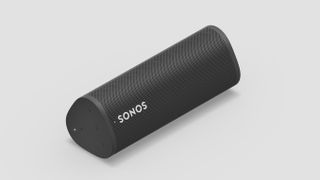Sonos Roam vs. Sonos Move: What's different?
How do the $169 Sonos Roam and $399 Sonos Move compare?

What's the difference between the Sonos Roam vs. Sonos Move? That's the first question I had when I learned the high-end speaker maker is launching a new wireless offering with a similarly kinetic name.
At $169, the Sonos Roam delivers what we felt Sonos Move lacked as the company's first speaker that can leave your home. The Move might be one of the best Bluetooth speakers overall, but it's bulky, making it a burden to carry around. It's rather expensive at $399, too.
The Roam is not only Sonos's most affordable speaker yet, it also weighs just a pound, making it the road warrior Sonos fans have been waiting for. That said, there are trade-offs between the Sonos Roam vs. Sonos Move that could make one of these models better for you than the other.
| Header Cell - Column 0 | Sonos Roam | Sonos Move |
|---|---|---|
| Price | $169 | $399 |
| Colors | Black, white | Black, white |
| Size | 6.5 x 2.5 x 2.5 inches | 9.4 x 6.3 x 4.9 inches |
| Weight | 0.9 pounds | 6.6 pounds |
| Durability | IP67 | IP56 |
| Battery life | 10 hours | 10 hours |
Sonos Roam vs. Sonos Move: Price
The Sonos Roam costs $169, making it the least expensive speaker ever from the audio savant. It's more accessible than the Sonos Move, which at $399, is one of the more costly wireless speakers on the market.
On paper the Roam seems like a better value for those always on-the-go, costing less than half of the Move. If you're in the market for a portable speaker and want to spend $50 or less, be sure to check out our list of the best cheap Bluetooth speakers.
Sonos Roam vs. Sonos Move: Design

For the Move, Sonos refreshed its design language. At 9.44 inches tall, the Move is a towering device. The all-black or all-white exterior and elliptical cylinder lend a sleek look, while the grille consumes an impressive amount of real estate.
The Roam looks like the Move encountered a vacuum bag. Measuring 6.5 x 2.5 x 2.5 inches and weighing less than a pound, its hand-held body is about one-sixth the size of its larger predecessor.
The Roam is also more triangular, with the grille covering two-thirds of the body and miniature rubber feet on the remaining side for supporting the speaker in a horizontal orientation (although it can stand up vertically, too.) Meanwhile, the Move offers just the one, upright orientation, supported by a wide rubber base.
Both ends of Sonos Roam are slightly concave to prevent accidental button presses. Those buttons are raised and tactile — a change from the flush, capacitive touch controls found on top of the Move.

As for durability, Sonos Roam is rated IP67, while the Move is rated IP56. IP56 means the Move is protected during rainy nights forgotten outside, but not total water submersion. The Roam is waterproof up to three feet deep for 30 minutes, making it more suitable for your poolside soundtracks.
Sonos Roam vs. Sonos Move: Sound quality
When it comes to engineering speakers, Sonos holds an esteemed track record. The Move offers a powerful listening experience with its tweeter, woofer and two amplifiers. It gets louder than the Sonos One, but maintains precise audio layering and body-shaking bass.

Based on size alone, it's unlikely the Sonos Roam will provide a comparable experience. Its performance will likely rival that of the UE Megaboom 3. Of course, Sonos's goal with Roam is to dominate all existing ultraportable alternatives.
The company could do that by ways of features, rather than speaker hardware. The Roam, like the Move, supports Auto Trueplay, an advanced version of the spatial-tuning technology from Sonos that lets the speakers automatically tune itself for the surroundings through their built-in microphones. Previously, Auto Trueplay only worked on Wi-Fi, but with the launch of Roam, Sonos is bringing the feature to Bluetooth mode for both speakers.

One perk the Roam has that the Move doesn't is a new tool called Sound Swap. Sound Swap easily tosses the Roam's music to the closet Sonos speaker in your home. You could do this from your phone at any time, but the option to do so from a physical button on the speaker could be a time-saver in some situations.
Sonos Roam vs. Sonos Move: Smart features and music services
As for listening options, the Sonos Move and Sonos Roam both offer over 100 streaming services via the Sonos app, but only when the device is connected to your Wi-Fi. Once you switch to Bluetooth, you can play audio direct only from music service apps like Spotify and Pandora.
Similarly, both speakers offer Alexa and Google Assistant, but only when connected to Wi-Fi. That means at home you can use hands-free voice control to change playback settings, as well as control any of best smart home devices compatible with your assistant of choice.
The Sonos Move is currently one of the best smart speakers, best Alexa speakers and best Google Home speakers, so the Roam has a big act to follow in the smart home space.
Sonos Roam vs. Sonos Move: Battery life

At launch, the Sonos Move offered 10 hours of battery life for active listening. Since then, the company pushed an update that granted the Move an additional hour of play time. In testing, we found the speaker more or less met battery life expectations.
The Sonos Roam is rated for 10 hours, which is a bit disappointing since UE Megaboom 3 lasts 20 hours on a charge, while the LG XBoom Go PL7 delivers an impressive 24 hours of playback. Ultraportable speakers should be able to survive a full day out without needing more juice.

As for power-saving features, the Move switches to suspend mode when it's not being used, allowing it to preserve battery life for up to 120 hours. When music isn't playing, Roam enters a sleep mode that can extend its stamina to 10 days.
Like the Sonos Move, the Roam has a custom charging base, but it comes at an additional charge of $49. Roam can also be charged with any Qi charger or via USB-C. The Move can also be charged via USB-C, but its charging base isn't included with purchase.
Sonos Roam vs. Sonos Move: Outlook
The Sonos Move was a game-changer for Sonos fans. For the first time, you could bring a Sonos-caliber speaker outside your home. By now, some of that novelty has worn off, especially with all the time we've spent indoors the past year. Still, inside, the Move is an excellent, full-bodied addition to any sound system. And it can travel from room to room with you.
If you're spending more time outdoors, the Roam is shaping up to be an attractive option. It's plenty durable and offered at a competitive price compared to the current top Bluetooth speakers. While we wish it had a longer battery life, it's probably the better choice for a more 'on-the-go' lifestyle.
- More: The best soundbars right now
Sign up to get the BEST of Tom’s Guide direct to your inbox.
Upgrade your life with a daily dose of the biggest tech news, lifestyle hacks and our curated analysis. Be the first to know about cutting-edge gadgets and the hottest deals.
Kate Kozuch is the managing editor of social and video at Tom’s Guide. She covers smartwatches, TVs and audio devices, too. Kate appears on Fox News to talk tech trends and runs the Tom's Guide TikTok account, which you should be following. When she’s not filming tech videos, you can find her taking up a new sport, mastering the NYT Crossword or channeling her inner celebrity chef.

